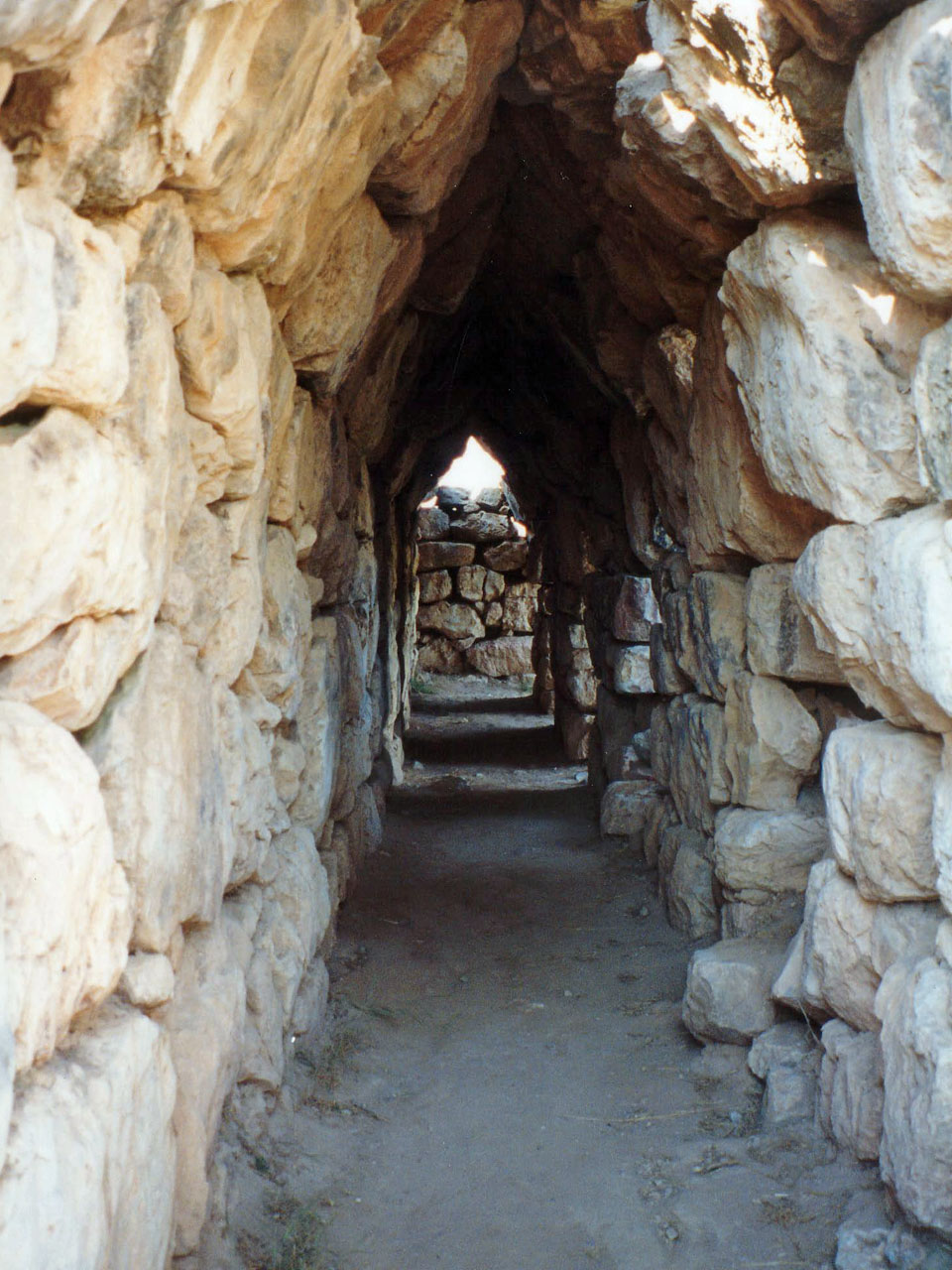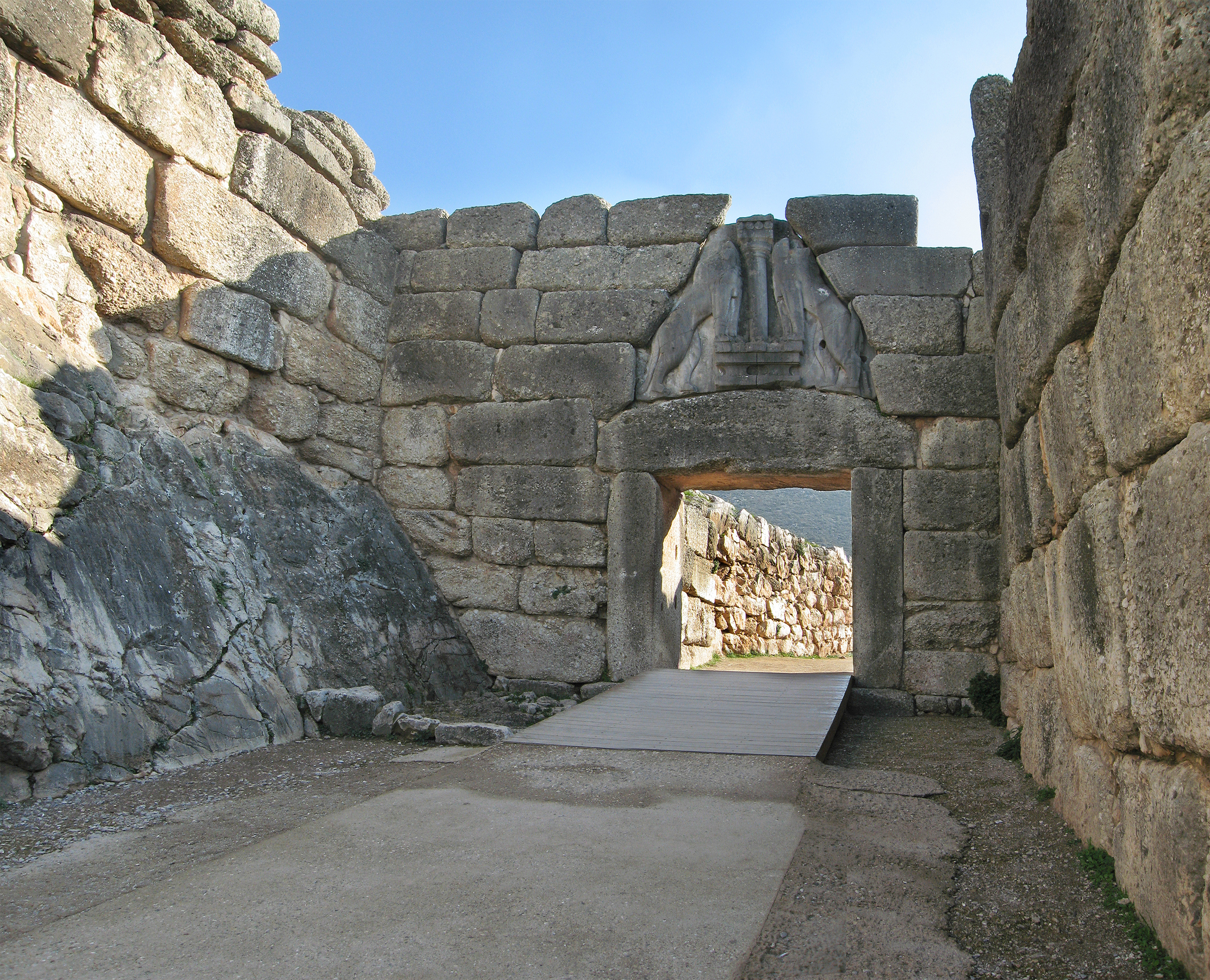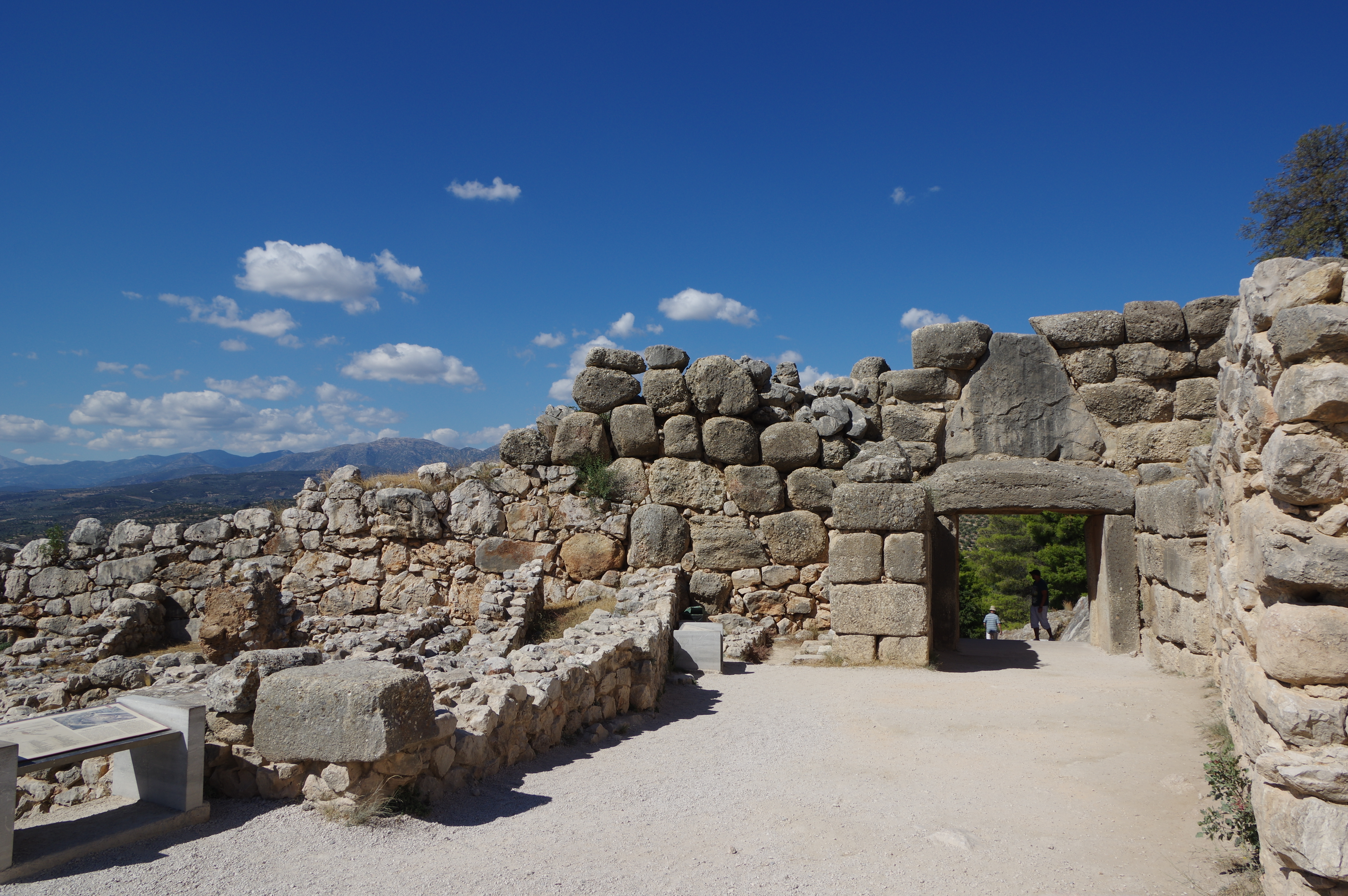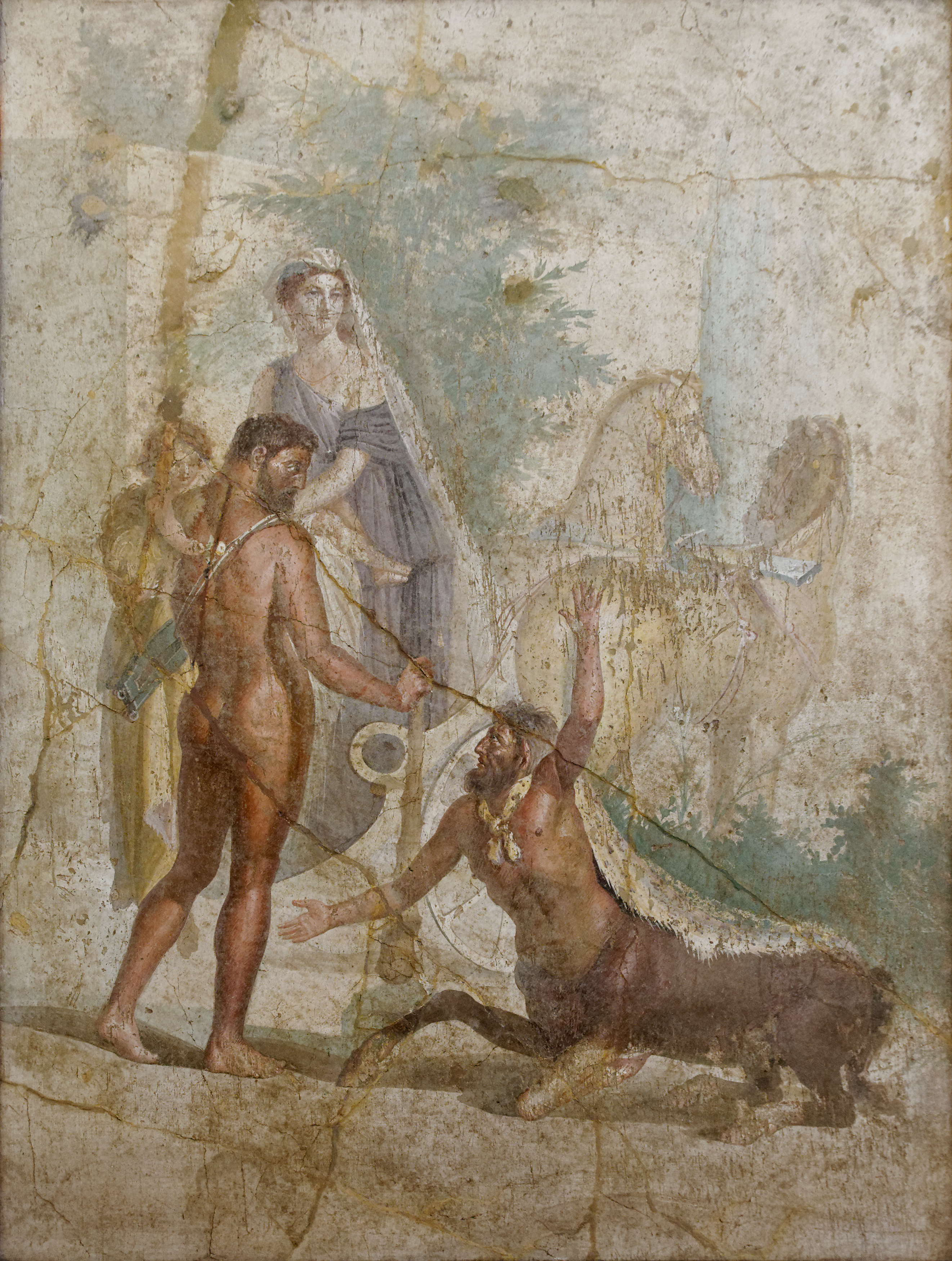|
Tiryns
Tiryns ( or ; Ancient Greek: Τίρυνς; Modern Greek: Τίρυνθα) is a Mycenaean archaeological site in Argolis in the Peloponnese, and the location from which the mythical hero Heracles was said to have performed his Twelve Labours. It lies south of Mycenae. Tiryns was a hill fort with occupation ranging back seven thousand years, from before the beginning of the Bronze Age. It reached its height of importance between 1400 and 1200 BC, when it became one of the most important centers of the Mycenaean world, and in particular in Argolis. Its most notable features were its palace, its Cyclopean tunnels and especially its walls, which gave the city its Homeric epithet of "mighty walled Tiryns". Tiryns became associated with the myths surrounding Heracles, as the city was the residence of the hero during his labors, and some sources cite it as his birthplace. The famous megaron of the palace of Tiryns has a large reception hall, the main room of which had a throne place ... [...More Info...] [...Related Items...] OR: [Wikipedia] [Google] [Baidu] |
Mycenaean Civilization
Mycenaean Greece (or the Mycenaean civilization) was the last phase of the Bronze Age in ancient Greece, spanning the period from approximately 1750 to 1050 BC.. It represents the first advanced and distinctively Greek civilization in mainland Greece with its palatial states, urban organization, works of art, and writing system.. The Mycenaeans were mainland Greek peoples who were likely stimulated by their contact with insular Minoan Crete and other Mediterranean cultures to develop a more sophisticated sociopolitical culture of their own. The most prominent site was Mycenae, after which the culture of this era is named. Other centers of power that emerged included Pylos, Tiryns, and Midea in the Peloponnese, Orchomenos, Thebes, and Athens in Central Greece, and Iolcos in Thessaly. Mycenaean settlements also appeared in Epirus, Macedonia, on islands in the Aegean Sea, on the south-west coast of Asia Minor, and on Cyprus, while Mycenaean-influenced settlements appeared ... [...More Info...] [...Related Items...] OR: [Wikipedia] [Google] [Baidu] |
Mycenae
Mycenae ( ; ; or , ''Mykē̂nai'' or ''Mykḗnē'') is an archaeological site near Mykines, Greece, Mykines in Argolis, north-eastern Peloponnese, Greece. It is located about south-west of Athens; north of Argos, Peloponnese, Argos; and south of Corinth. The site is inland from the Saronic Gulf and built upon a hill rising above sea level. In the second millennium BC, Mycenae was one of the major centres of Greek civilisation, a military stronghold which dominated much of southern Greece, Crete, the Cyclades and parts of southwest Anatolia. The period of History of Greece, Greek history from about 1600 BC to about 1100 BC is called Mycenaean Greece, Mycenaean in reference to Mycenae. At its peak in 1350 BC, the citadel and lower town had a population of 30,000 and an area of . The first correct identification of Mycenae in modern literature was in 1700, during a survey conducted by the Venetian engineer Francesco Vandeyk on behalf of Francesco Grimani, the Provveditore Ge ... [...More Info...] [...Related Items...] OR: [Wikipedia] [Google] [Baidu] |
Cyclopean Masonry
Cyclopean masonry is a type of stonework found in Mycenaean architecture, built with massive limestone boulders, roughly fitted together with minimal clearance between adjacent stones and with clay mortar or no use of mortar. The boulders typically seem unworked, but some may have been worked roughly with a hammer and the gaps between boulders filled in with smaller chunks of limestone. The most famous examples of Cyclopean masonry are found in the walls of Mycenae and Tiryns, and the style is characteristic of Mycenaean fortifications. Similar styles of stonework are found in other cultures and the term has come to be used to describe typical stonework of this sort. The term comes from the belief of classical Greeks that only the mythical Cyclopes had the strength to move the enormous boulders that made up the walls of Mycenae and Tiryns. Pliny's ''Natural History'' reported the tradition, attributed to Aristotle, that the Cyclopes were the inventors of masonry towers, giving ... [...More Info...] [...Related Items...] OR: [Wikipedia] [Google] [Baidu] |
Cyclopes
In Greek mythology and later Roman mythology, the Cyclopes ( ; , ''Kýklōpes'', "Circle-eyes" or "Round-eyes"; singular Cyclops ; , ''Kýklōps'') are giant one-eyed creatures. Three groups of Cyclopes can be distinguished. In Hesiod's ''Theogony'', the Cyclopes are the three brothers, Brontes, Steropes, and Arges (Cyclops), Arges, who made Zeus's weapon, the thunderbolt. In Homer's ''Odyssey'', they are an uncivilized group of shepherds, the brethren of Polyphemus encountered by Odysseus. Cyclopes were also famous for being the builders of the Cyclopean masonry, Cyclopean walls of Mycenae and Tiryns. In ''Cyclops (play), Cyclops'', the fifth-century BC play by Euripides, a satyr play, chorus of satyrs offers comic relief based on the encounter of Odysseus and Polyphemus. The third-century BC poet Callimachus makes the Hesiodic Cyclopes the assistants of smith-god Hephaestus, as does Virgil in the Latin epic ''Aeneid'', where he seems to equate the Hesiodic and Homeric Cyclop ... [...More Info...] [...Related Items...] OR: [Wikipedia] [Google] [Baidu] |
Megaron
The ''megaron'' (; , , : ''megara'' ) was the great hall in very early Mycenae, Mycenean and Ancient Greece, ancient Greek palace complexes. Architecturally, it was a rectangular hall that was supported by four columns, fronted by an open, two-columned portico, and had a central, open hearth that vented though an Oculus (architecture), oculus in the roof. The ''megaron'' also contained the Throne room, throne-room of the ''Anax, wanax'', or Mycenaean ruler, whose throne was located in the main room with the central hearth. Similar architecture is found in the Ancient Near East, though the presence of the open portico, generally supported by columns, is particular to the Aegean civilization, Aegean. ''Megara'' are sometimes referred to as "long-rooms", as defined by their rectangular (non-square) shape and the position of their entrances, which are always along the shorter wall so that the depth of the space is larger than the width.. There were often many rooms around the centra ... [...More Info...] [...Related Items...] OR: [Wikipedia] [Google] [Baidu] |
Heracles
Heracles ( ; ), born Alcaeus (, ''Alkaios'') or Alcides (, ''Alkeidēs''), was a Divinity, divine hero in Greek mythology, the son of ZeusApollodorus1.9.16/ref> and Alcmene, and the foster son of Amphitryon.By his adoptive descent through Amphitryon, Heracles receives the epithet Alcides, as "of the line of Alcaeus (mythology), Alcaeus", father of Amphitryon. Amphitryon's own, mortal son was Iphicles. He was a descendant and half-brother (as they are both sired by the god Zeus) of Perseus. He was the greatest of the Greek heroes, the ancestor of royal clans who claimed to be Heracleidae (), and a champion of the Twelve Olympians, Olympian order against chthonic monsters. In Roman mythology, Rome and the modernity, modern western world, West, he is known as Hercules, with whom the later Roman emperors, in particular Commodus and Maximian, often identified themselves. Details of his cult (religion), cult were adapted to Rome as well. Origin Many popular stories were told ... [...More Info...] [...Related Items...] OR: [Wikipedia] [Google] [Baidu] |
Acrisius
In Greek mythology, Acrisius (; Ancient Greek: Ἀκρίσιος means 'ill-judgment') was a king of Argos. He was the grandfather of the famous Greek demi-god Perseus. Family Acrisius was the son of Abas and Aglaea (or Ocalea, depending on the author), grandson of Lynceus, great-grandson of Aegyptus. He was the twin brother of Proetus and the half brother of Lyrcus. Acrisius was the husband of Eurydice or Aganippe and thus grandfather of the hero Perseus through their daughter Danae. His other daughter was Evarete, wife of King Oenomaus of Pisa in Elis. Mythology Rivalry of twins Acrisius and Proetus were said to have quarrelled even in the womb of their mother and when Abas died and Acrisius had grown up, he expelled Proetus from his inheritance. On his exile, Proetus was supported by his father-in-law Iobates, the Lycian, Proetus returned, and Acrisius was compelled to share his kingdom with his brother by giving Tiryns to him, while he retained Argos for him ... [...More Info...] [...Related Items...] OR: [Wikipedia] [Google] [Baidu] |
Hera
In ancient Greek religion, Hera (; ; in Ionic Greek, Ionic and Homeric Greek) is the goddess of marriage, women, and family, and the protector of women during childbirth. In Greek mythology, she is queen of the twelve Olympians and Mount Olympus, sister and wife of Zeus, and daughter of the Titans Cronus and Rhea (mythology), Rhea. One of her defining characteristics in myth is her jealous and vengeful nature in dealing with any who offended her, especially Zeus's numerous adulterous lovers and illegitimate offspring. Her iconography usually presents her as a dignified, matronly figure, upright or enthroned, crowned with a ''polos'' or diadem, sometimes veiled as a married woman. She is the patron goddess of lawful marriage. She presides over weddings, blesses and legalises marital unions, and protects women from harm during childbirth. Her sacred animals include the Cattle, cow, cuckoo, and Peafowl, peacock. She is sometimes shown holding a pomegranate as an emblem of immort ... [...More Info...] [...Related Items...] OR: [Wikipedia] [Google] [Baidu] |
Proetus
In Greek mythology, Proetus (; Ancient Greek: Προῖτος ''Proitos'') may refer to the following personages: * Proetus, king of Argos and Tiryns, son of Abas and twin brother of Acrisius. *Proetus, a prince of Corinth as the son of Prince Thersander, son of King Sisyphus. He was the father of Maera who died a maiden. Scholiasts on the ''Odyssey'' confound him with the Argive Proetus. *Proetus of Thebes, eponym of the Proetid Gates, and father of Galanthis. *Proetus of Nauplia, a son of Nauplius I and father of Lernus. *Proetus, a son of Agenor (?). It is unclear whether StephanusStephanus of Byzantium, s.v. ''Thasos'' is referring to a son of Agenor named Proetus, or to the Argive Proetus as a descendant of Agenor. Notes References * Antoninus Liberalis, ''The Metamorphoses of Antoninus Liberalis'' translated by Francis Celoria (Routledge 1992)Online version at the Topos Text Project.* Apollodorus, ''The Library'' with an English Translation by Sir James George ... [...More Info...] [...Related Items...] OR: [Wikipedia] [Google] [Baidu] |
Peloponnese
The Peloponnese ( ), Peloponnesus ( ; , ) or Morea (; ) is a peninsula and geographic region in Southern Greece, and the southernmost region of the Balkans. It is connected to the central part of the country by the Isthmus of Corinth land bridge which separates the Gulf of Corinth from the Saronic Gulf. From the late Middle Ages until the 19th century, the peninsula was known as the Morea, a name still in colloquial use in its demotic form. The peninsula is divided among three administrative regions: most belongs to the Peloponnese region, with smaller parts belonging to the West Greece and Attica regions. Geography The Peloponnese is a peninsula located at the southern tip of the mainland, in area, and constitutes the southernmost part of mainland Greece. It is connected to the mainland by the Isthmus of Corinth, where the Corinth Canal was constructed in 1893. However, it is also connected to the mainland by several bridges across the canal, including two submers ... [...More Info...] [...Related Items...] OR: [Wikipedia] [Google] [Baidu] |






